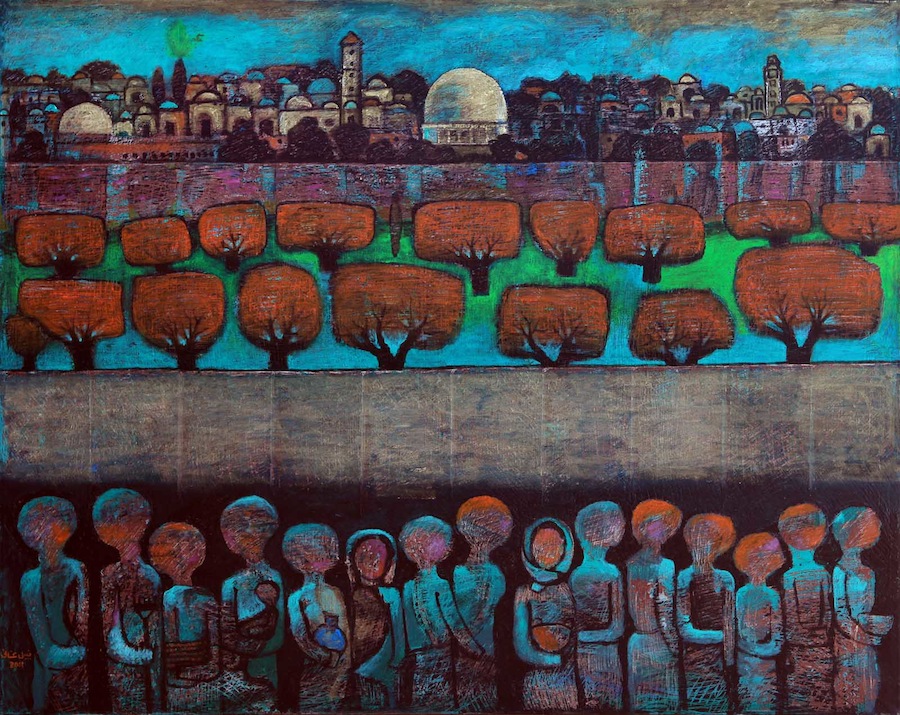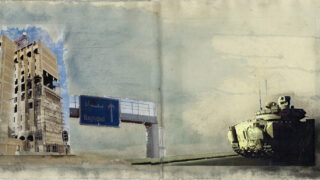Translation by: Palestine Square
At a time when leadership and institutional vacuums in Jerusalem have left Palestinians there without representation, it is impossible to assess the Palestinian economy in the city, and further afield, in isolation from politics. This was made apparent yet again in recent months, with four specific developments exposing the extent to which nearly 350,000 Palestinian Jerusalemites have been marginalized and ignored, not to say exploited, as they persist in remaining in their city despite unceasing Israeli measures to drive them out and Judaize Jerusalem—the largest Palestinian city and the slated capital of the State of Palestine. The four developments concerned are: visits by high-ranking US and French delegations; the ten-year $38 billion US military aid package to Israel, unveiled in mid-September 2016; the latest announcement of European development aid to Palestine; and, lastly, the fate of Jerusalem in the now postponed Palestinian municipal elections. Fifteen years ago, Jerusalem was the single most important indicator of success or failure of the so-called peace process/political solution (during the Camp David negotiations) and in the Palestinian revolt against the occupation (when the Second Intifada was ignited). The thread linking these four seemingly disparate events reveals the extent to which Jerusalem has lost its centrality in the Israeli-Palestinian conflict.
Delegations Come and Go
In the context of deadlocked negotiations since 2014 and the absence of any prospect for their resumption in the current geopolitical calculi of the big powers, and in the shadow of the most rightwing and hawkish Israeli government in years, a number of “unofficial” meetings occurred between visiting Western diplomats and prominent Jerusalemites in the early months of last summer, mostly off- the-record and casual discussions held around dinner tables on the sidelines of official meetings in Ramallah. These unofficial talks, which variously included French Prime Minister Manuel Valls, members of the American-Palestinian Joint Economic Committee, and more recently the US deputy assistant secretary of state for foreign assistance, revolved around the deteriorating living conditions of Palestinians and how these might be alleviated. The Palestinian interlocutors in those talks (business people, tourism, legal, and economics experts, as well as social and youth activists) laid out the disturbing facts that are fueling dangerous levels of poverty and unemployment in Jerusalem, including dwindling manufacturing, the endangered tourism industry, the rising tax burden, and the near-absence of municipal services, including education and housing. While Valls listened attentively as his interlocutors urged him to pursue international action to protect Jerusalem’s Palestinians from continued Israeli pressure to either drive them out or become “Israelized,” he was primarily concerned with relaying that the Palestinian question had fallen low on the hierarchy of French priorities (after terrorism, migrants, Syria, Iran, Iraq, Egypt, and even Saudi Arabia), and that Palestinians should appreciate that France still regarded Palestine as a priority at all. In other words, that Palestinians should put up and shut up.
The US representatives of an outgoing administration for their part had little to offer to allay Jerusalemites’ concerns. They focused the discussion on “creating opportunities,” putting forth ideas such as hi-tech incubators and youth training programs that emphasized job application and other life skills, and were reluctant to become involved in investment of any sort, or discuss the possibility of loans or aid. So, if not actual jobs, at least their suggestions could provide some hope! When it was pointed out that such suggestions were inadequate to fight 30% employment, 82% poverty, a collapsed tourism sector, overcrowding in the city, growing drug addiction, skyrocketing school dropout rates, and a host of other problems, the Americans had little to proffer given USAID’s refusal to implement projects in the city, part of a US policy not to antagonize Israel over Jerusalem—at least since Oslo.
One of the Palestinians taking part in these unofficial talks noted that it was impossible to walk around the West Bank (including Area C directly controlled by Israel) without noticing the plethora of billboards proclaiming “a gift from the American people to the Palestinian people,” or reaffirming cooperation with the Palestinian Authority (PA) with lofty slogans such as “We Invest in Infrastructure.” He also noted that US aid was disbursed to Hamas-controlled Gaza via NGOs as well as UN agencies. In East Jerusalem, by contrast, there was not a road, school, or clinic, or even a trash receptacle that was a gift from the American people to the Arab population, as though they were not under occupation and were not part of the Palestinian people somehow.
Loyalty and Generosity: Israel First
Against this backdrop, and despite a spate of liberal commentary speculating that Obama may yet bolster his legacy on Palestine with a bold action at the UN,[1] the outgoing president’s last address to the General Assembly in October tells another story: the US president took the opportunity to mend fences with Netanyahu, not much of a hardship since the $38 billion US military aid package to Israel had been announced days earlier.
None of this is to say that the United States ignores Palestine altogether on the aid front. In fact, an annual amount roughly equal to 10% of US military aid to Israel is allocated to the occupied Palestinian territories (oPt) other than East Jerusalem. In 2015, the US provided approximately $365 million to the West Bank and Gaza Strip,[2] some of it in budgetary support to the PA, some to UN development and humanitarian agencies, and the remainder to NGOs as well as American subcontractors and local Palestinian contractors providing administrative, legal, or technical services to US-funded projects. It should be noted here that a sizable portion of the American people’s gift to the Palestinian people is actually spent on the salaries of American project supervisors at the embassy in Tel Aviv, and on paying Israeli companies that provide them with office supplies and equipment¾including Eden bottled water from the occupied Golan Heights! One doesn’t know whether to laugh or cry at the many programs promoting coexistence, forgiveness, and cooperation between Palestinians and Israelis that are an abiding source of American pride: carried out by notable liberal Israeli organizations such as Sikkuy, Ben Gurion University in the Negev, Eid Dor Museum of Archeology, the Arava Environmental Institute, all the way to the Peres Center for Peace, these programs are all registered as American aid to the Palestinian people. Thank you, Uncle Sam!
In that it doesn’t completely overlook the needs of Jerusalem, the European stance is a little more nuanced in its pro-Israel bias, with 10 million Euros earmarked for Palestinian projects in the city, from a total of $40 million Euros in overall “development” aid (the latter figure is a mere 10% of the European aid package to the PA). Be that as it may, these projects, which are for the most part cultural, educational, and sports-related, have little bearing on the overall situation: they neither challenge the occupation nor do they address what have become disastrous living conditions and constitute little more than a confirmation of Manuel Valls’ remark that the Palestinians “have not been forgotten.” In fact, some of the projects are outright ridiculous, as for example, the construction of a luxurious modern tennis court in the heart of the Old City, undoubtedly to encourage Jerusalem’s children to take up this little-known sport. It is difficult to see how such insignificant and marginal efforts can change Palestinian reality in any way, or even constitute a message to the besieged and isolated Jerusalemites—except maybe that they should be resisting with tennis rackets and balls!
Where is Jerusalem on the Political Map?
Other than for Israel, which pursues its plans there with impunity, it is clear that East Jerusalem counts for little in the political calculus of governments that are supposedly concerned about the city. East Jerusalem’s complete absence of representation within the Palestinian political system ever since the death of Faisal Husseini 15 years ago (as he shuttled between Arab capitals pleading for his city during the early months of the Second Intifada) and Israel’s closure of PLO offices in East Jerusalem and suspension of all Palestinian political activity have left a gaping vacuum, which exists despite the fact that a PA cabinet position, a government department, as well as a number of PLO committees and funds are dedicated exclusively to East Jerusalem—all of them powerless to do anything inside the city. The resulting absence of any economic, social, or planning vision or policy goals on the ground in turn reinforces donor countries’ lackluster response to the needs and aspirations of its residents.

Despite Jerusalem’s marginalization and all the political posturing in its name, neglect of the city has not gone completely unheeded. In August 2016, a lawyer from Jerusalem successfully challenged the Palestinian municipal elections that were set for November (now postponed) because they excluded Jerusalemites (15% of the West Bank’s Palestinian population). And the question of municipal representation has now been taken up by the PLO’s Palestinian Planning Center, which recently convened meetings to look into the reactivation of Amanat al-Quds (Al Quds Municipality, the name of the last Arab-Jordanian-local government there), a political initiative launched by the late PLO chairman and president Yasir Arafat to which President Abbas recommitted in 2014. Reviving this local government institution even by decree if not through elections might not be particularly significant for Jerusalemites’ access/rights to democratic political representation but it would pave the way for the consolidation and mobilization of resources in support of the city and help address some of its most pressing economic and social problems.
Although meetings and symposiums alone cannot save Jerusalem, and although there were other reasons for postponing the Palestinian elections, the fact that East Jerusalem’s political representation now figures in the domestic conversation points to the city’s enduring status as the Gordian knot within the Palestinian political and legal system. And that is the good news from Palestine!






